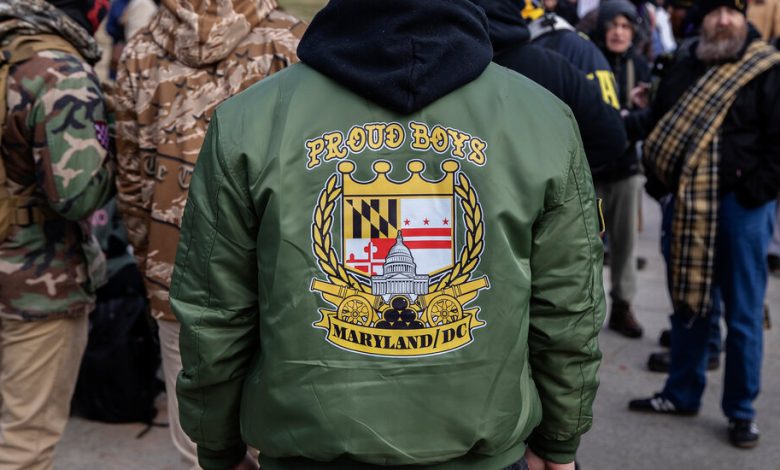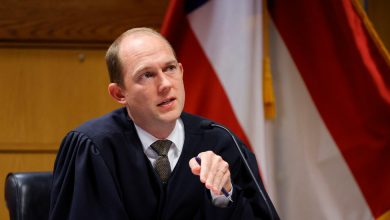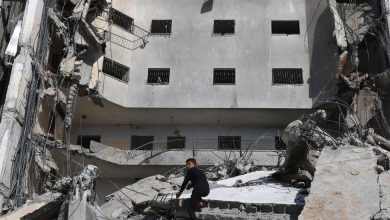Four Takeaways From the Proud Boys Jan. 6 Sedition Trial So Far

For nearly a month, the seditious conspiracy trial of five members of the Proud Boys has been plodding along in Federal District Court in Washington, often getting bogged down in arcane arguments about what sorts of evidence can be offered to the jury.
The government’s presentation so far has managed to demonstrate that the far-right group had a culture of violence that emerged at pro-Trump rallies in Washington before the attack on the Capitol on Jan. 6, 2021. But in its first few weeks, it has only glancingly advanced the central allegation in the case: that the men conspired to use force after the 2020 election to stop the lawful transfer of presidential power.
This week, however, prosecutors introduced evidence that more directly implicated the defendants: Enrique Tarrio, who once led the Proud Boys, and Ethan Nordean, Joseph Biggs, Zachary Rehl and Dominic Pezzola, four of his subordinates.
Prosecutors showed the jury a recording of a video meeting from Dec. 30, 2020, in which Mr. Tarrio and other Proud Boys leaders gave instructions for Jan. 6. They also delved into a huge trove of as many as a half-million Telegram messages exchanged by the defendants and other Proud Boys, most of them written in group chats bearing names like Skull and Bones, Ministry of Self-Defense Leaders and OG Pickleback Crew.
Here are four takeaways from what the messages and the video showed.
Trump’s call out to the Proud Boys left them elated.
Since their founding during the 2016 presidential race, the Proud Boys have been ardent defenders of Donald J. Trump, adopting his attitude of male grievance and showing up to back him and his policies at events, well before Jan. 6.
But even after years of vocal — and sometimes violent — support for Mr. Trump, the Telegram messages showed the Proud Boys were bowled over when he called them out by name during a presidential debate in September 2020, telling the group to “stand back and stand by.”
The immediate reaction among those in the “Official Presidents Chat” was wide-eyed elation.
“HE SAID OUR NAME!!!” wrote Mr. Nordean.
Minutes later, Mr. Biggs wrote: “My phone hasn’t stopped ringing.”
A Proud Boy using the screen name Chris Cannon Pb seemed astonished by how Mr. Trump’s highly public mention would spread news about the group.
“Boys, we are the #1 media point from the largest debate that has ever been seen or heard in the history of the world,” he wrote. As he added shortly after, “We are bigger than Jesus.”
Some members of the chat tried to figure out what Mr. Trump had actually meant.
“I read it as stand by, don’t engage immediately but be ready to go,” wrote John C. Stewart, a Proud Boys leader from Pennsylvania, who has since pleaded guilty in the case.
A Proud Boy using the name D-Bow the Viking appeared to be less interested in parsing the specifics of the statement than in focusing on the tone.
“Donald has given us a command,” he wrote.
A melee turned Proud Boys members against the police.
Throughout the trial, one of the government’s key claims to the jury has been that even though the Proud Boys have traditionally maintained close relations with the police, they turned against law enforcement in the weeks leading up to Jan. 6, contributing to the group’s violence against officers at the Capitol.
The disillusionment began, the government has said, on the evening of Dec. 12, 2020, after a pro-Trump rally in Washington, when Jeremy Bertino, a high-ranking Proud Boy from North Carolina, was stabbed during a melee with leftist counterprotesters. The Proud Boys blamed the police for not protecting them.
On Thursday, prosecutors played clips from the Proud Boys video meeting that seemed to corroborate these claims.
At one point during the meeting, Aaron Wolkind, the vice president of the group’s Philadelphia chapter, tells his compatriots that their “disposition toward the police needs to be re-evaluated.” Mr. Wolkind suggests that the group eschew their typical black-and-yellow uniforms and disguise their identities in public, adopting tactics from their adversaries in the leftist antifa movement.
Mr. Biggs, using multiple obscenities in the same short sentence, suggests taking a more aggressive stance toward the police. That echoed something he had written two weeks earlier on social media, which was also shown to the jury on Thursday.
“If police block electors from entering a building to cast a vote for Trump, we the people will treat your thin blue line like we do antifa,” Mr. Biggs wrote in the message posted on Dec. 14, 2020, the day that some Trump supporters tried to enter state capitols to cast false votes for Mr. Trump in the Electoral College.
“Get in our way and get walked over,” the post went on. “You will become the enemy of the state.”
The group had an early focus on the Capitol.
Prosecutors turned on Friday to showing the jury a series of Telegram messages suggesting that the Proud Boys were focused on the Capitol as some sort of target by late December 2020.
On Dec. 20, for example, Mr. Stewart, the Pennsylvania Proud Boy, wrote in a chat called Ministry of Self-Defense Leaders that the group’s “main operating theater” on Jan. 6 “should be out in front of the Capitol building.”
“That’s where the vote is taking place,” he went on, “and all the objections.”
Two weeks later, in the same group chat, a Proud Boy using the name Gabriel PB announced, “Yes sir, time to stack those bodies in front of Capitol Hill.”
Shortly after, another member using the name Jake Phillips wrote, “What would they do if 1 million patriots stormed and took the capital building. Shoot into the crowd? I think not.”
Then, two days before Jan. 6, Mr. Tarrio sent a message indicating that some of his compatriots had been talking about breaking into the building in an audio file that was posted to the group chat.
“I didn’t hear this voice note till now,” he responded on Jan. 4, 2021, with his own audio file. “You want to storm the Capitol.”
“Minecraft”? They used their own lingo.
The Proud Boys, like any gang, have long had an internal lingo, communicating together in a kind of collective code. One of their common slogans — “Proud of Your Boy” — was adopted ironically from a song from the Broadway musical “Aladdin.” Another catchphrase — “Uhuru” — is the Swahili word for “freedom.”
On Wednesday, Conor Mulroe, a prosecutor on the case, said that the word “Minecraft” — a reference to the popular video game — appeared frequently in the Telegram chats as a cipher meaning “violence.”
“It’s a somewhat tongue-in-cheek tagline they put at the end of a statement when it’s a facially incriminating statement,” Mr. Mulroe told Judge Timothy J. Kelly, who is overseeing the case.
On Thursday, the government showed the jury several examples of how the Proud Boys used the term.
On Oct. 6, 2020, Mr. Rehl, the president of the group’s Philadelphia chapter, posted a message to the “Official Presidents Chat” complaining about restrictions put in place because of the pandemic.
“I really hope to see people start fighting back against these tyrants, in minecraft,” he wrote.
Five days before the group marched on the Capitol, Mr. Stewart used the term in response to a post about the police in Washington closing roads on Jan. 6.
“Let’s quit playing games and oblige them … in Minecraft,” he wrote.
Then, on Jan. 4, 2021 — the day Mr. Tarrio was arrested after an act of vandalism at a previous pro-Trump rally in Washington — Mr. Wolkind posted a message in which he seemed to be advising his fellow Proud Boys not to communicate openly about criminal activity.
“If you’re talkin about playing Minecraft,” he wrote, “you just make sure you don’t use your phone at all or even have it anywhere around you.”




